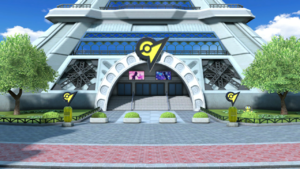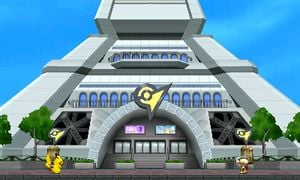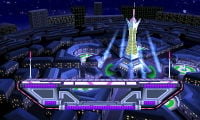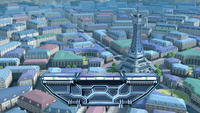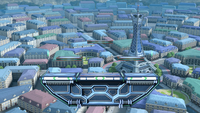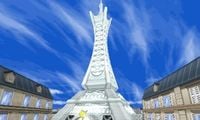Prism Tower
| Pokémon X & Pokémon Y Prism Tower | |
|---|---|
 Prism Tower as it appears in Smash. | |
| Universe | Pokémon |
| Appears in | SSB4 (3DS) Ultimate |
| Availability | Starter |
| Crate type | Presents (3DS) Normal (Ultimate) |
| Maximum players | 8 (Ultimate only) |
| Article on Bulbapedia | Lumiose Gym |
| “ | The tower in Lumiose City from Pokémon X and Pokémon Y. The platforms that the fighters battle on float around the tower itself. | ” |
| —Super Smash Bros. 4 Official Site | ||
Prism Tower (プリズムタワー, Prism Tower) is a stage in Super Smash Bros. for Nintendo 3DS and Super Smash Bros. Ultimate. It originates from the Pokémon universe and is set in Lumiose City of the Kalos region.
Stage overview[edit]
The stage begins on the streets in front of the tower's base in broad daylight. A few seconds into the battle, moving platforms will appear and must be jumped onto to begin the ascent to the top. Near the top, the sun begins to set, and it turns nighttime once at the top, where the players can continue to fight.[1] Eventually, the platform flies away from the tower, then down back to the front of the tower's base as daylight returns. The stage always plays out in a set order for the same amount of time.
Like Saffron City, Pokémon Stadium 2, and Spear Pillar, there are Pokémon that appear in the background. Helioptile can be seen on the ground, while Magnemite, Zapdos, Emolga, and Yveltal can be seen while the platform flies around the tower (save for Yveltal, all the appearing Pokémon are Electric-type, matching the theme of the Lumiose City Gym). The base of the tower features two televisions that cycle between advertisements. These include advertisements for Pokémon-Amie, Trainer PR Videos, Roller Skates, the Gogoat Shuttle, Holo Casters, and film advertisements featuring Kalos Champion Diantha, a Lucario, and another indistinguishable character.
Ω forms and Battlefield form[edit]
In Super Smash Bros. for Nintendo 3DS, the Ω form is set on a metallic platform far above the ground, with the city seen in the background.
In Super Smash Bros. Ultimate, the Ω form and Battlefield form are similar to SSB4's Ω form; however, the main platform is redesigned, and it is resized and reshaped to match Final Destination and Battlefield, respectively. The three soft platforms of the Battlefield form resemble the ones in the normal form. Unlike in SSB4, where the stage always takes place at night, Ultimate's variants feature a day-night cycle.
Tournament legality[edit]
In Super Smash Bros. for Nintendo 3DS, Prism Tower was a counterpick stage. However, despite not having intrusive hazards, it still has many features considered unusual for legal stages in SSB4, such as being a touring stage with an initial walkoff section and another section with multiple platforms with grabbable edges. Its status as a legal stage is largely owed to the poor availability of competitively suitable stages in the 3DS version, and due to its unpopularity in competitive settings, Prism Tower is hardly ever seen in competitive play.
In Super Smash Bros. Ultimate, Prism Tower is universally banned, thanks to the larger availability of more conventional competitive stages.
Update history[edit]
- Prism Tower's on-screen appearances and revival platforms locations have been changed.
Origin[edit]
In Pokémon X and Y, Lumiose City is at the center of the Kalos region and is the largest city in the Pokémon world. The Prism Tower, in Centrico Plaza, also serves as the Lumiose Gym, where the player battles Clemont—an Electric-type specialist—for the Voltage Badge after solving a series of questions involving Pokémon. The design of the Prism Tower is based on the Eiffel Tower (Lumiose City itself is based on Paris).
In terms of design, the tower in Smash has a composite between its game version (with the more arched entrance, the yellow gym leader symbol, and more outside flora) and its anime version (with more tinted windows and glass doors). In addition to the elements of both versions, the entrance also has monitors with advertisements, which could be found throughout the rest of the city in the original game.
With the exception of the legendary Pokémon Zapdos and Yveltal, the Pokémon that appear in the background seem to reference Clemont's team in his Gym Battle; Emolga, Heliolisk and Magneton (the latter two being evolved forms of Helioptile and Magnemite).
Trophy[edit]
The Prism Tower trophy is exclusive to Super Smash Bros. for Nintendo 3DS.
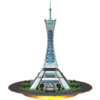
- Prism Tower
A notable location from Pokémon X and Pokémon Y. The Prism Tower is the symbol of Lumiose City, the metropolis at the heart of the Kalos region. In this game, platforms will take you on a tour around the tower and its surrounding areas, and at night you can marvel at the fabulous illuminations. You may see different Pokémon, as well.
A notable location from Pokémon X and Pokémon Y. The Prism Tower is the symbol of Lumiose City, the metropolis at the heart of the Kalos region. In this game, platforms will take you on a tour around the tower and its surrounding areas, and at night you can marvel at the fabulous illuminations. Of course, you may run into a Pokémon, too.
Gallery[edit]
Super Smash Bros. for Nintendo 3DS[edit]
Super Smash Bros. Ultimate[edit]
Palutena in her cyan alternate costume on the stage.
Charizard using Flare Blitz on the stage.
The female trainer throwing a Poké Ball on the stage.
Greninja using it’s up smash on the stage.
Names in other languages[edit]
Trivia[edit]
- In Ultimate, the following Assist Trophies can only appear on the Battlefield and Omega forms of this stage: Nightmare, Andross, Color TV-Game 15, Devil, Dr. Kawashima and the Ghosts. The Moon cannot be summoned on this stage at all.
References[edit]
